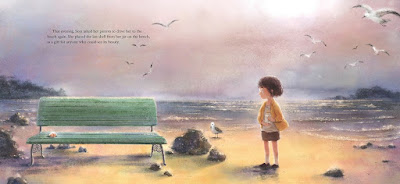"Look at that one!
Rapunzel!! Rapunzel!!
Let down your hair!
Those are CIRRUS
clouds, and they
are basically a lot of
microscopic ice crystals.
CIRRUS is the Latin word
for curl of hair."
As the sun shines brightly this morning, there is no cloud in the sky. If there were clouds, I would use this quite remarkable and very informative book to help me make an identification! It seems the perfect book to have with you when you are out for a drive, or on a long trip. I would guess the more often you are able to name the type of cloud you are seeing, the more capable you will become at knowing what you are looking at!
Two tiny rabbits are suitably intrigued by what they see when they look up, while outside playing. The spectacled one has the book needed to help them determine what type of cloud is there. The other is quick to provide a personal observation. The cloud is identified. A small inset note at the bottom of the spread offers further information.
Similar conversations follow, with dramatic effect provided at every turn until the one in glasses is terrified by a BOOM of thunder, and the other explains:
Well, actually ... CUMULONIMBUS clouds
are very scary. Because they can bring
thunder, lightning, wind, hail, and even
tornadoes, which I learned ...
from YOU."
In the final spread, the two are enjoying a relaxed swing, while simply determining what the clouds they are seeing look like to them in the moment. The blue-sky watercolor backgrounds allow interested readers a chance to observe a clear look as each type is described, both imaginatively and scientifically.
An author's note shares that she has always loved to paint clouds, and the learning she did to write a book about them. She follows her note with further back matter that includes how clouds form, the ten main types of clouds, the earth's water cycle, a list of resources for interested kids and a selected bibliography.




















































